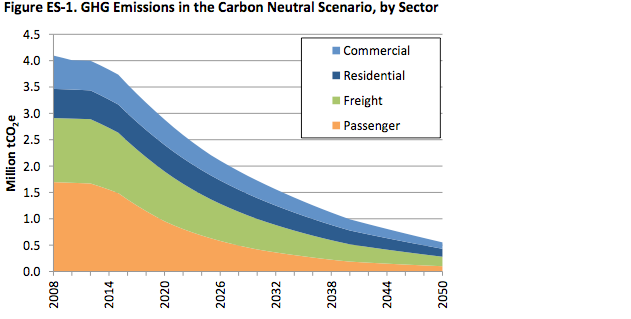Cross-posted from ThinkProgress Green.
Over 80 percent of Americans and over half of the world’s population live in cities. By 2050, over 70 percent of the global population is expected to be urban. By then — less than four decades away — human civilization needs to be carbon neutral if we are to have any hope of averting catastrophic climate change. Figuring out how to eliminate greenhouse pollution from cities is a necessary component of that challenge.
The city of Seattle, a global leader in the fight against climate change, commissioned the Stockholm Environment Institute, Cascadia Consulting Group, and ICF International “to develop a scenario [PDF] of how the city might be able to achieve carbon neutrality” by 2050:
- Shifting to less GHG-intensive travel modes such as ride sharing, transit, walking, and biking, to produce a 30 percent reduction in per capita travel in light-duty vehicles by 2030 and a 50 percent reduction by 2050, relative to 2008 levels.
- Dramatically increasing energy efficiency in building design and operations, as well as in vehicle efficiency, to produce over 30 percent in energy savings by 2030 (per capita in residential, per square foot in commercial, and per mile in vehicles) and over 50 percent by 2050, relative to 2008 levels.
- Transitioning homes, businesses, and vehicles to lower-carbon energy sources: electricity (or possibly hydrogen) in the long run, biofuels as a bridging strategy for transportation until electric vehicles predominate, and to a much lesser extent, sustainable biomass sources (for district energy systems).

Although the scenario is ambitious within constraints that are reasonable given present-day economics and politics, it could have gone much further. The authors only plot out a pathway to 90 percent reductions by 2050, instead of actually achieving carbon neutrality or even carbon negativity — the “climate positive” pathway of actually reducing carbon concentrations in the atmosphere, not just carbon emissions. One problem with the economic models used is that in the “business as usual” scenario — in which there is no reduction of greenhouse-gas emissions — per capita income grows by 250 percent by 2050. That’s an absurd result to expect in such a polluted world, where ecological services will have collapsed and global war is a plausible outcome.




